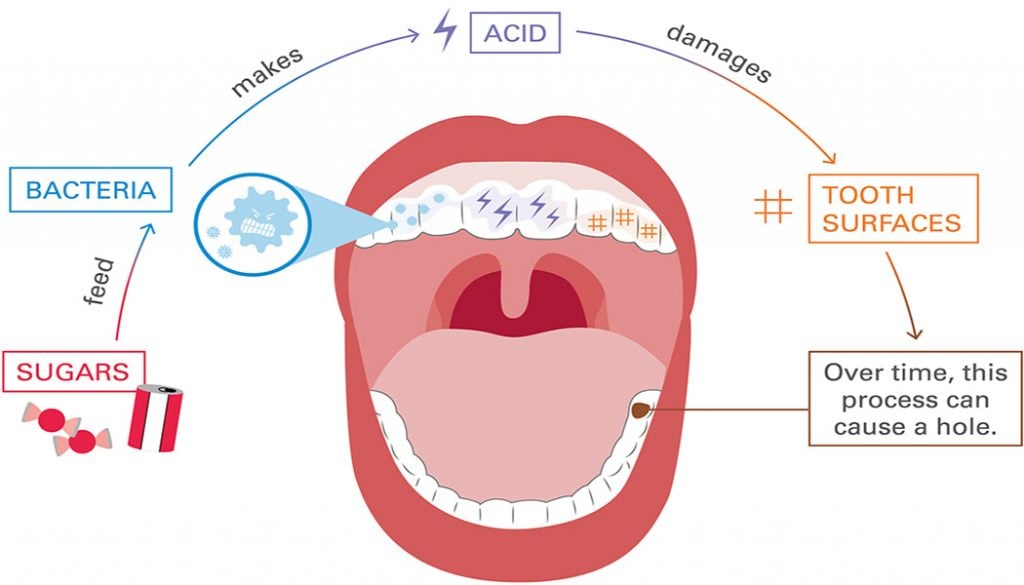What can cause decay?
Posted by: Jodie Blades Diploma Level 3 in Dental Nursing
Medically reviewed by: Dr Anthony Lam BDS (Hons), MSc (Lond), MOrth RCS (Edin)
”Dental decay is the leading cause of hospital admissions for 5-9yr olds in the UK. But, it's completely preventable!
What can cause decay?
The process of dental decay or caries is a cycle of demineralisation and remineralisation. What we eat and drink and how we maintain our oral health are the factors that cause decay. Caries permanent damage to tooth enamel. Unlike dentine, once enamel is damaged, it will not regenerate. Cavities and tooth decay are among the world’s most common health problems and it is the leading cause of hospital admission for children in the UK. They’re especially common in children, teenagers and older adults. But anyone who has teeth can get cavities, including infants.
1. Plaque begins to form
Every time we eat we leave food particles in a sticky film that coats our teeth. This is exaggerated when you eat lots of sugars and starchy foods and by not cleaning your teeth well. As soon as the food particles have been left on the teeth, bacteria quickly begin feeding on them and form plaque. Plaque that stays on your teeth can harden under or above your gum line into calculus or tartar. Tartar makes plaque more difficult to remove and creates a shield for bacteria.
2. Bacteria creates acid
The bacteria feeding on the plaque create acids. The acids begin to destroy and remove minerals in your tooth’s hard, outer enamel. This erosion causes tiny holes in the enamel — the first stage of decay. You’re not likely to feel the decay in its early stages so it’s incredibly important to visit your dentist regularly for check-ups as decay first appears white and chalky. If we spot it early, you can change your habits, increase your fluoride and brushing and we can arrest the decay in its tracks and stop it progressing further. Once areas of enamel are worn away, the bacteria and acid can reach the next layer of your teeth, called dentin. This layer is softer than enamel meaning decay can run rife.
3. Progression of decay
Once the enamel has been compromised tooth decay continues to develop, the bacteria and acid continue their march through your teeth. If left untreated, the decay can move to the next layer of your tooth- the inner tooth material (pulp) that contains nerves and blood vessels. This is when you’re likely to get a toothache. The pulp becomes swollen and irritated from the bacteria. Because there is no place for the swelling to expand inside of a tooth, the nerve becomes pressed, causing pain. Discomfort can even extend outside of the tooth root to the bone and abscesses can be formed.
Fighting decay
Your saliva has the hard task of neutralising the acids that cause decay. You can help by decreasing the number of ‘acid attacks’ on your teeth but reducing the frequency of your snacking. Also, choose ‘tooth-friendly’ snacks with little or no sugar and avoid carbonated drinks. The better hydrated you are too, the better your saliva can fight decay – so sip water regularly.
Preventing Dental Decay
- Brush with fluoride toothpaste after eating or drinking. Brush your teeth at least twice a day and ideally after every meal, using fluoride-containing toothpaste. To clean between your teeth, floss or use interdental brushes.
- Rinse your mouth. If your dentist feels you have a high risk of developing cavities, we recommend that you use a mouth rinse with fluoride.
- Attend the dentist regularly. Get professional teeth cleanings and regular oral exams, which can help prevent problems or spot them early. Your dentist can recommend a schedule that’s best for you.
- Attend the hygienist regularly. Visiting the hygienist will remove any built-up plaque and calculus removing breeding grounds for bacteria, helping to prevent dental decay.
- Dental sealants. A sealant is a protective plastic coating applied to the chewing surface of back teeth. It seals off the deep grooves called fissures that tend to collect food, protecting tooth enamel from plaque and acid. The Centers for Disease Control and Prevention (CDC) recommends sealants for all school-age children. Sealants may last for several years before they need to be replaced, but they need to be checked regularly.
- Avoid frequent snacking and sipping. Whenever you eat or drink beverages other than water, you help your mouth bacteria create acids that can destroy tooth enamel. If you snack or drink throughout the day, your teeth are under constant attack.
- Eat tooth-friendly foods. Some foods and drinks are better for your teeth than others. Avoid sticky foods that get stuck in grooves and pits of your teeth for long periods, or brush soon after eating them. However, foods such as fresh fruits and vegetables increase saliva flow, and unsweetened coffee, tea and sugar-free gum help wash away food particles.
- Fluoride treatments. If you’re a high-patient then we may recommend periodic fluoride varnishes or custom trays that fit over your teeth for application of prescription fluoride. Especially if you aren’t getting enough fluoride through fluoridated drinking water and other sources or you have a medical condition that reduces saliva flow.
Do you have dental decay? Book a New Patient Exam Today!


Sorry, the comment form is closed at this time.